Abstract
This article aims to present the results of an applied research in which origami technique has been used as a corrective-recuperative method in the process of training and education of children with mental disabilities. Through its peculiarities, origami technique can receive, depending on the context, but also on the teacher’s skills, psychotherapeutic valences similar with ludotherapy, art-therapy, occupational therapy or ergotherapy. The research was conducted on a special category of subjects (children with mental disabilities from a special primary school), because we considered that this is the best period when they can acquire much more certain skills, abilities and capabilities so that to become able to realize the transfer of knowledge and to make connections, thus stimulating their rigid thinking. We emphasize that the success of such an approach is based on the fact that the technique should be applied systematically and methodically during several consecutive years. "Exercises" must be adjusted to the individual possibilities of children, because this training must be done in full cooperation with them in order to stimulate their self-confidence and thus to develop also their personality traits and behaviour. Basic assumptions of the research were: 1. the use of origami techniques in educating children with mental disability improves fine motor skills; 2. the use of origami techniques improves the level of mental functioning of the following processes:
Keywords: Origamimental disabilitycorrective-recuperative methodeducationpersonality traits
Introduction
Over time, people have folded paper for different purposes such as for making religious offerings
which were burned at Chinese Buddhist funerals or were hung in Japanese Shinto temples; as a method of
packing gifts and money used by the upper classes of the samurai; as a recreational way to spend time
with family; as a mean of developing patience, skill and artistic sense in kindergartens and schools; as a
tool of educating the spatial view and forms perception for a better and easier understanding of the plane
geometry and especially of the space geometry in schools, colleges and universities (Japan, Germany,
United States, Israel); as ludotherapy, art-therapy, occupational therapy or ergotherapy for psychiatric
patients or for patients with various sensory-motor disabilities (old people or people who suffered all sorts
of accidents); as art!
The novelty of this research is that proposes the origami technique as a methodically and
systematically way for cognitive and sensory-motor stimulation of children with mental disabilities, for at
least one year of study of an optional curriculum, created for this purpose. Origami technique is seen in
this study as a set of exercises meant to train, to correct and to improve the intellectual capacity of
children with mental disability, to provide them the opportunity to gradually overcome some mental
barriers. This study assumes theoretical and demonstrates practical that the optimal time to intervene with
the aid of corrective-recuperative origami technique in the process of education of children with mental
disability is the elementary school age. At this age, compensatory reserves of the body, based on a better
plasticity of the central nervous system, lead to better results, sometimes amazing, the consolidation of
confidence and self-esteem being beneficial for pupil adaptation to other disciplines workloads and also
for correcting his school conduct.
Mental Disability - Theoretical Guidelines
Mental deficiency with all related issues: definition, terminology, diagnosis, etiology, legislation,
sociology, therapeutic or psycho-pedagogical methods, remains extremely complex and often confusing
or even contradictory. When we speak about the mental deficiency, not only the sphere of conceptual
definitions is different from one author to another, from one area of activity to another (psychiatry,
psychology, pedagogy, social security etc.), but also the terminology in which synonymy such as
handicap, deficiency, disability does not bother as much as the terms that cause confusion (backwardness,
delay, failure, weakness) and can induce the idea of possible return to normal. (Verza, 1998). Currently,
terms such as "handicap" and "handicapped" is recommended to be replace by "disability" and "person
with disability" in order to protect human dignity. (WHO, 2001).
Peculiarities of Psychical Process and Personality at the Children with Mental Disability
To use the most effective and appropriate means of education, correction and rehabilitation of
children with mental disabilities is necessary to have detailed and profound knowledge about peculiarities
of upper and lower cognitive mental processes and to identify the specifics of their personality, in order to
act especially at those levels that can decisively contribute in the process of education and of socio-
professional integration and to avoid items that may constitute vulnerabilities. In other words, it has to be
identified "the strengths" and "the weaknesses" of the personality of each student. Of the many characteristic aspects of mental deficiency, perhaps the most impressive aspect, by its vulnerability, is the
emotional-affective structure, the fragility of personality construction and the infantilism behavioural.
Teachers, who are working with such pupils, frequently face with their emotional lability, with their
accentuated fear of making mistakes, with their infantilism and lack of motivation and with their lack of
control behavior, often expressed through aggressiveness or violence.
Because the stated purpose of this paper refers only secondarily to the mental processes and
personality characteristics of pupils with mental disabilities, we will not insist on them. We will remind
only those concepts, constituted in true theoretical guidelines, which have guided us in using the origami
technique to pupils with mental deficiency:
incompetence (Doll); the fragility of personality construction and the behavioral infantilism (Lewis &
Fau) (Verza, 1998; Gherguţ, 2007). To those peculiarities of mental processes and of personality of
children with mental disabilities, synthesized in theoretical frameworks enshrined in literature, may be
added many other constants from the concrete activities undertaken with pupils, including:
concentrate his attention on the relative size of the surrounding stimuli and inability to secure or
organize, in an effective manner, the elements of a work task.
The key concept from which started the experimental part of this study was the one of the
development of cognitive functions and thinking. Therefore, intelligence arises from action, in its
entirety, as transformers of objects and reality and the child work to assimilate knowledge is active and
operative. To understand child development, in general, and children with mental disabilities, in
particular, it is necessary to examine the evolution of perceptions, the perception being a particular case
of sensory-motor activities.
Educational and Therapeutic Valences of Origami Art
In Europe, the German educator Friedrich Froebel (1782-1852), who founded the preschool child
education in kindergartens, tried to introduce a number of origami models, who were a novelty and
represented the most important part of the kindergartens curriculum, but without results. Remarkably, at
that time, in Japan, origami was not studied by children from the state education system. The art of
folding paper began to be used as an educational method in the Japanese kindergartens and primary
schools, considering that: deepens the insight about the essential shape of an object, the objects being
simplified to some defining characteristics and makes easier for children to understand geometry
(Kobayashi, 2007). One of the pupils who benefited from this measure was Akira Yoshizawa, who, after
the Second World War, became master of origami and contributed to its spread worldwide (Engal, 2010).
Regarding the study of origami technique, Akira Yoshizawa together with the American Sam Randlett,
created a conventional language of graphic representation for folding the origami shapes, which led to the
spread and diversification of origami technique and brought origami on a high level of art (Jackson,
2009). In many worldwide schools, colleges and universities, origami was used for various purposes.
Thus, in Germany, Bauhaus Academy of Architecture and Decorative Arts has included origami among
courses for students; in U.S., mathematical studies combined with the I.T. techniques, allowed Robert
Lang, a physicist, theorist and artist of origami to discover the mathematical algorithm that allow
"computerized design" of an origami with multiple engineering applications (e.g. folded mirrors for
orbital stations, folded airbags) and in marketing and advertising (Lang, 2008); in Japan, the patience is
tested by JAXA (Japanese Space Agency), to which one of the admission tests for candidates is to fold
1.000 paper cranes (
using origami of outside Japan, it seems to be in Israel where, over 10.000 children from the public
education system are studying geometry using origami. The link between origami and geometry is also
suggested by the name of the discipline:
In Romania, in the past, without knowing that it was named origami, in some kindergartens,
children learned to fold paper in order to manufacture various items (salt shakers, glasses, helmets, frogs).
The idea of Friedrich Froebel has been used especially in schools for disabled children, but it has been
used sporadic, unsystematic, focusing more on the origami technique as a method of practical skills
development, without knowing or without acknowledging about its complex of educational values. In the
eighties,
other activities, were presented a number of origami folds. Currently, in special education, origami is
taught in the form of simple and sporadic activities, to the classes of training and development of practical
skills. Through its peculiarities, origami is approaching to occupational therapy, but it is more attractive,
more motivating, more challenging. Having a strong playful character, this technique incite: the child
practices, memorizes and strives, playing! With each new test begins: to fold fairer and faster -
comparisons. Without realizing it, begins to distinguish various types of paper -
forms -
the perception of the shape and of the dimensions of objects; that, in time, pupils learn to differentiate the
two-dimensional objects from the three-dimensional objects. For example, at the beginning, children
make confusion between square and cube, between circle and sphere. After they repeatedly transformed
squares of paper into cubes (
confusion (La Fosse, 2011). They also learn correctly the names of the geometrical figures: square,
rectangle, triangle, circle, cube and sphere. In addition, through origami, while they are playing, they
learn geometry elements: diagonal sides, angles; they learn to divide surfaces into halves and quarters and
angles in halves.
If we want origami technique to be valued in all its educational and therapeutically aspects (art-
therapy, ergotherapy, occupational therapy), corrective and recuperative aspects should be studied in a
level of pupils with mental disability (Potolea et al., 2012).
Research Design
Purpose of Research
method in the education process of the primary school age children with mental disabilities.
other years of study in the same school, in other special schools or in the mainstream education.
Objectives of Research
In the present research, there were targeted theoretical objectives and applicative objectives:
education process of primary school children with mental disabilities, and 2.
integration of pupils with mental deficiency, improving educational deficiencies, behavioral and
emotional.
4.2.2.The applicative objectives, derived from the theoretical objectives were: 1. the elaboration of
named: “Origami - We learn by playing”; 2. the elaboration of a method to teaching origami technique
to the children with mental deficiency;
materials that can be used in teaching origami, technological education, geometry or in logotherapy and
psychotherapy cabinets
Research Hypotheses
Basic assumption of the research were: H1 - It is supposed that the usage of origami techniques in
educating pupils with mental deficiency improves fine motor function; H2 - It is supposed that, the
origami technique used in educating pupils with mental deficiency, contribute to the improvement of the
functioning of the following psychological processes:
development of spatial view and perception of forms),
capacity) and
Research Group
In order to do our applicative research, we have established a lot of 27 students (14 girls and 13
boys), aged between 10 and 12 years, from
conducted over a school year, special education, where the class time is 45 minutes and origami technique
is taught one hour a week. To better understand characteristics of the lot of students we have presented
processing of data by gender and degree of mental deficiency results in next figure:

Research Methods
The research was conducted in three distinct stages: initial, intermediate and final, each containing
specific objectives.
applying a test for measuring their sensory-motor skills, spatial view and forms perception, ability to
concentrate attention and the capacity of memorize.
assessment of pupils through direct observation and by analyzing their archived works at the end of each
origami class, in their individual notebooks, so that it could be seen the time evolution of each of them
embodied in their partial qualificatives. Their notebooks were transformed in
extremely useful tools in monitoring the progress of pupils.
assessment by applying the same test administered at the initial stage.
Science the space of this study does not permit a detailed description of each step; we will refer
just to the aspects of research that highlights the purpose and objectives of the fund's research, namely:
origami as a corrective-recuperative method with educational valences for elementary school age. For
the initial and final evaluation of the pupils, was performed a test inspired by origami technique in order
to assess the degree of skill, the capacity to focus attention and to memorize the successive stages
necessary for fulfilling the task. All indications were given oral and frontal, because some pupils cannot
read, while some others really hard. In the envelope that they had received were four origami pieces and a
paper with assembly instructions pictures. We will present the origami test and how it was applied.
a. Each student received a form of evaluation test and 4 pieces of paper folded in origami technique:

b. On a piece taken as an example, it is shown to the students the jointing points as: pockets and spur:
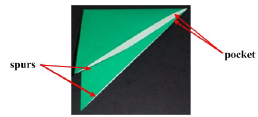
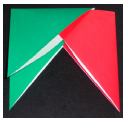
d. It is stated that they must respect the same sense of bonding:
e. It is shown how to look the final work,achieved by assembling the 4 parts:
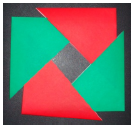
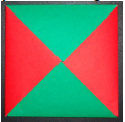
f. At the end of the test each pupil had to put the four pieces of paper (total or partial assembled)
back in the envelope.
Working time was of 15 minutes and the score was calculated as follows: 10 points are granted by
default, the rest of the score had to be achieved by the number of assembled parts according to the
following scale: each piece used - 7.5 points; for each correct connection - 15 points; for each incorrect
link - 7.5 points. In the following table have been mentioned all the variants of solving the test, taking
into account: 1. the number of parts used by each student; 2. the number of the connections made, the
correct one being dotted different from the incorrect one; 3. the set score from the correction scale.
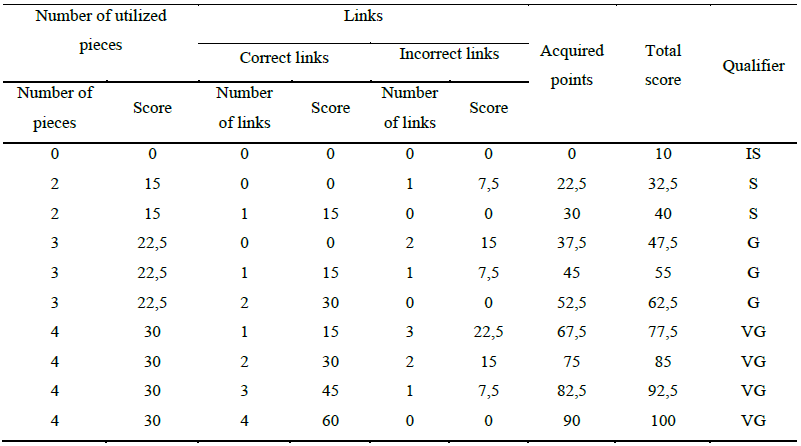
Taking into account that in the primary school are granted qualificatives, after processing data
from the table above, it was specified rating based on the total score and there were established scores for
the granting of qualifier, as follow: Insufficient (IS) - (0 ÷ 30); Sufficient (S) - (30 ÷ 45); Good (G) - (45
÷ 70) and Very Good (VG) - (70 ÷ 100).
At this stage of research was conducted comparative analysis of data obtained by administering the
same test at the beginning of the school year (initial evaluation) and the end of the school year (final
evaluation) and interpretation of these data. The results achieved by the benchmark tests (initial and final)
were processed and interpreted graphical using MS-Excel program.
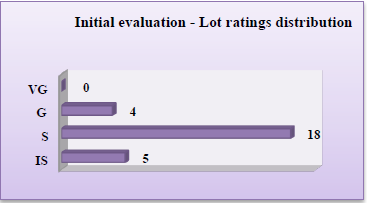
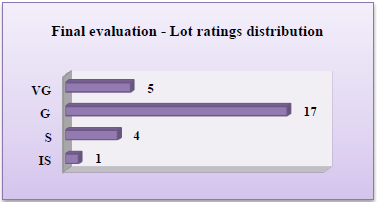
Looking at these two charts, we can say that the overall evolution of the pupils is obvious. If in the
initial assessment, the majority of pupils was denoted by qualifier Sufficient (18 pupils), in the final
assessment, the majority is denoted by the qualifier Good (17 pupils) - the small number of qualifier
Good from the initial evaluation (4) equals the number of qualifier Sufficient from the final assessment
(4). In the initial assessment not a single student was rated Very Good, but in the final evaluation 5 pupils
have obtained this qualification. But the most impressive, given the degree of mental deficiency of the
pupils, is the evolution of the Insufficient qualifier, which was obtained in the initial testing by five
pupils, and in the final testing only by one pupil. The results of the final evaluation test indicate a positive
overall assessment which emerges also from the pupils' notebooks (continuous assessment), from direct
observation, but also from others teacher assessments. Due to the way it was designed the evaluation test,
the final results indicates a positive evolution of fine motor skills, of the perceptual skills, of the ability to
concentrate attention and of their capacity to memorize. Therefore, these results confirm those two
hypotheses (H1 and H2). In addition to these positive results, the methodical practicing of origami
technique led to: improve the working climate during class; improving the relationship between pupils;
strengthening confidence and self-esteem to most of them. The findings of this research certify that
origami becomes a corrective-recuperative method with rich educational valences in training and
education of pupils with mental disability, with one condition:
Conclusions
Through its peculiarities, origami technique can receive, depending on the context, but also on the
teachers’ skills, psychotherapeutic valences similar with ludotherapy, art therapy, occupational therapy or
ergotherapy and moreover, can be used as a corrective-recuperative method in the process of training and
education of children with mental disabilities from primary school. At the end of the research we
concluded that this is the best period when they can acquire much more certain skills, abilities and
capabilities so that to become able to realize the transfer of knowledge and to make connections, thus
stimulating their rigid thinking. We emphasize that the success of such an approach is based on the fact
that the technique should be applied systematically and methodically during a year of study, ideally over
several consecutive years.
When we talk about pupils with mental disability, the method of teaching is very important and
requires understanding of origami technique. If someone will use origami technique only as a mean of
developing practical skills, will never reach to understand its complex therapeutic values. As noted, the
technique should be used primarily as a mean of increasing the capacity of concentration, the capacity to
memorize, the discipline of thinking and to improve pupil conduct. Only under these conditions, origami
technique can improve fine motor skills and ultimately improves pupil’s skills and practical skills (Toma
et al, 2009). With improved life skills, child gains confidence, strengthens self-esteem and become more
motivated and interested in the acquisition of new knowledge, new technical skills.
And we must not forget that all this things are happening while pupils are playing!
References
- Engal, P. (2010). Origami odissey. Hong Kong: Ed. Tuttle Publishing, pp. 16-17.
- Gherghuţ, A. (2007). Sinteze de psihopedagogie specială. Ghid pentru concursuri şi examene de obţinere a gradelor didactice. Iaşi: Ed. Polirom, pp. 144-146.
- Jackson, P. (2009). Origami.Bucureşti: Ed. M.A.S.T, p. 41.
- Kobayashi, K. (2007). Origami booklet. Using Edo chiogami. Tokyo: Ed. K. K. Ikeda Shoten.
- La Fosse, M. (2011). Geometric origami. Tokyo: Ed. Tuttle Publishing.
- Lang, R. (2008, February). The math and the magic of origami [Video file]. Retrieved from http://www.ted.com/talks/robert_lang_folds_way_new_origami.html Piaget, J., & Inhelder, B. (1972). Psihologia copilului. Bucureşti: E. D. P.
- Potolea, D., Toma S., Cerkez, M., Borzea, A., Căpiţa, L., & Tacea, F. (2012). Coordonate ale unui nou cadru de referinţă al curriculumului naţional. Bucureşti: E.D.P.
- Roach, M. (2010). Packing for Mars: The curious science of life in the void. Oxford: Oneword Publications.
- Toma, S., & Popa, N. (2009). Origami technique in technological education lessons. Proceedings of The National Simposium - SINUC 2009. Technical University of Civil Engineering Bucharest: Conspress. CD-ROM..
- Verza, E. (1998). Psihopedagogie specială. Bucureşti: E.D.P., pp. 23-25.
- World Health Organization (2001). International classification of functioning, disabilities and health: ICF. Geneva.
Copyright information

This work is licensed under a Creative Commons Attribution-NonCommercial-NoDerivatives 4.0 International License.
About this article
Publication Date
25 May 2017
Article Doi
eBook ISBN
978-1-80296-022-8
Publisher
Future Academy
Volume
23
Print ISBN (optional)
-
Edition Number
1st Edition
Pages
1-2032
Subjects
Educational strategies, educational policy, organization of education, management of education, teacher, teacher training
Cite this article as:
Osiceanu, E., & Eremia, D. (2017). Origami Used as a Corrective-Recuperative Method for Children with Mental Disabilities. In E. Soare, & C. Langa (Eds.), Education Facing Contemporary World Issues, vol 23. European Proceedings of Social and Behavioural Sciences (pp. 1320-1328). Future Academy. https://doi.org/10.15405/epsbs.2017.05.02.162
